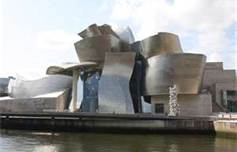
Bilbao on the Baltic?
The Helsinki City Council has finally decided. No Guggenheim for them, thank you very much. The city of Helsinki, chosen over Taipei, Rio de Janeiro and Guadalajara to join the ranks of existing and planned Guggenheims in New York, Venice, Bilbao, Berlin and Dubai, decided in the end that they just didn’t have the stomach for it.
International cutting-edge art is expensive, and Europe’s in recession. Although Finland is one of the few countries left in the EC not to have lost its triple A rating, there is still real economic pain abroad in the land. People have been laid off. Companies have closed their doors. The government is cutting funding for health care, education and –ahem- local Finnish art museums.
So, it didn’t sit too well with the Finns that the Guggenheim feasibility study alone cost the city of Helsinki over a million Euros. The next stages of the project, were they to go ahead, had been estimated at over five million Euros. And you know how it is. It always costs more than the estimates.
The Finns have a history of living within their means. They were the only country to pay back their World War One war debt to the United States. They dug deep and paid back the Russian war reparations after the Second World War. They’ve become the wealthy country they are only relatively recently. Many Finns still think poor.
But that wasn’t the only reason the Finns were against the idea of a Helsinki Guggenheim. Most local Finnish artists came out against it. It was felt that the Guggenheim would be sure to go in for the big international names and neglect home-grown talent. It was felt that there already were several excellent art, design and architectural museums in Helsinki and just maybe the vast sums of money needed for the Guggenheim project could be used to support them instead.
Seventy-five percent of the Finnish population was against it (according to a March poll) and thought the money would be better used to build a new library in Helsinki.
And even the politicians were against it in the end, or many of them anyway. The Green Party was against it. So, too, were the Social Democrats, the left Alliance and even the far right-wing True Finn Party. Only the National Coalition and the Swedish People’s Party supported it.
After the fact it was going to be exorbitant, the main reason everyone was against it was that it wasn’t going to be controlled by Finns. There was a lot of suspicion of American motives. The Finns have always been leery of foreigners coming into their country and taking things over.
And can you really blame them? In addition to having a history of having to live within their means, the Finns also have a history of not being in control of their own destiny. For 600 years, they were a colony of the Swedish Empire (when there was such a thing), and for the next 100, they were a grand duchy of the Russian one. Though compared to the way subject peoples were treated in the African, Asian and South American colonies of the European powers, the Finns didn’t have it so bad, the Finns don’t necessarily see it that way. No one likes it when someone else is telling them what to do. No one likes it when they’re treated as inferior.
And even after Independence, the Finns could never really relax, not with Russia right next door. So, it’s true, and regrettable, but there is a lot of anti-foreign sentiment in the country, and this, coupled with a healthy desire not to bankrupt themselves was enough to put a stop to the project.
Or was it?
The director of the Guggenheim, Richard Armstrong , wants to wait until the upcoming October Helsinki municipal elections and try to push the project through again. He feels that there might be enough of a change in the political make-up of the Helsinki City Council to get the Guggenheim museum a yes vote. After all, the rejection vote was 8-7. Hardly a unanimous decision.
So who knows? There may just be a Bilbao on the Baltic after all. We’ll have to wait until the fall to see.





I love the valuable info you supply in your posts. I like your writing style.
http://www.KneeNeckBackPain.com/
Much appreciated! I try to post once a week. Keep reading!
Pretty nice post. I just stumbled upon your blog and wished to say that I’ve really loved browsing your blog posts. In any case I’ll be subscribing on your rss feed and I’m hoping you write once more very soon!
Thanks very much. I should be posting again next week some time.After that, I am off on my European summer vacation and should be posting from France and and Spain.
I’ll be posting from Spain tomorrow and from France next week.
I wanted to follow up and allow you to know how great I treasured discovering your blog today. I’d consider it a real honor to work at my place of work and be able to utilize tips shared on your website and also be involved in visitors’ responses like this. Should a position of guest publisher become available at your end, i highly recommend you let me know.
I’ll be sure to let you know if I need a guest publisher!
Aw, this was a actually good post. In concept I wish to put in writing like this in addition ?taking time and actual effort to make an superb post?nonetheless what can I say?I procrastinate alot and by no indicates appear to get something done. 127060
Thanks for helping out, superb information . 464965
Thank you for any other informative blog. Where else may just I am getting that kind of info written in such a perfect way? 977481
amazing post, quite informative. I wonder why the other experts of this sector do not notice this. You ought to continue your writing. I
It’s also WordPress I’m afraid.
Amazing! This blog looks exactly like my old one! It’s on a completely different topic but it has pretty much the same layout and design. Great choice of colors!
Good read, I just passed this onto a colleague who was performing slightly research on that. And he just bought me lunch since I identified it for him smile So let me rephrase that: Thank you for lunch! 683411
Quite intriguing topic , thanks for posting . 553164
You need to participate in a contest for among the most effective blogs on the internet. I will recommend this site! 615696
Thanks for providing such a fantastic write-up, it was superb and really informative. It is my very first time that I pay a visit to here. I located plenty of informative stuff inside your write-up. Maintain it up. Thank you. 619171
Awesome material you fellas got these. I really like the theme for the web site along with how you organized a person who. It
Good post. I learn something a lot more challenging on different blogs everyday. It will always be stimulating to read content material from other writers and practice a bit something from their store. I
Thanks for that.
As soon as I found this web site I went on reddit to share some of the love with them.
Very good blog! Do you have any tips and hints for aspiring writers? I’m planning to start my own site soon but I’m a little lost on everything. Would you propose starting with a free platform like WordPress or go for a paid option? There are so many choices out there that I’m totally overwhelmed .. Any ideas? Thank you!
As long as you have someone to set up the word press for you and show you a thing or two. then you can easily run it yourself.